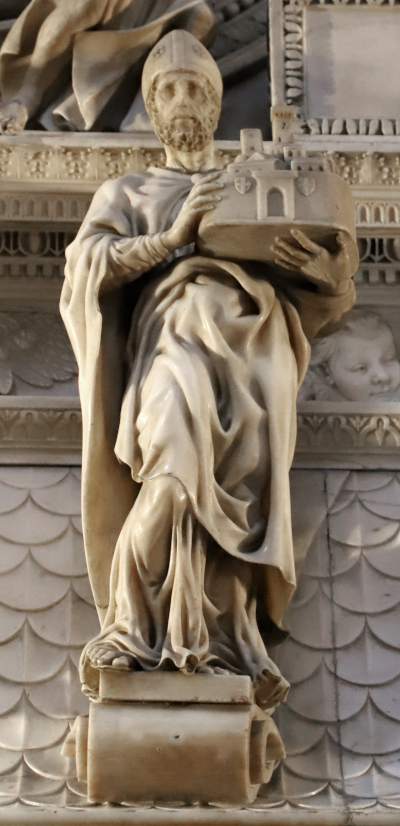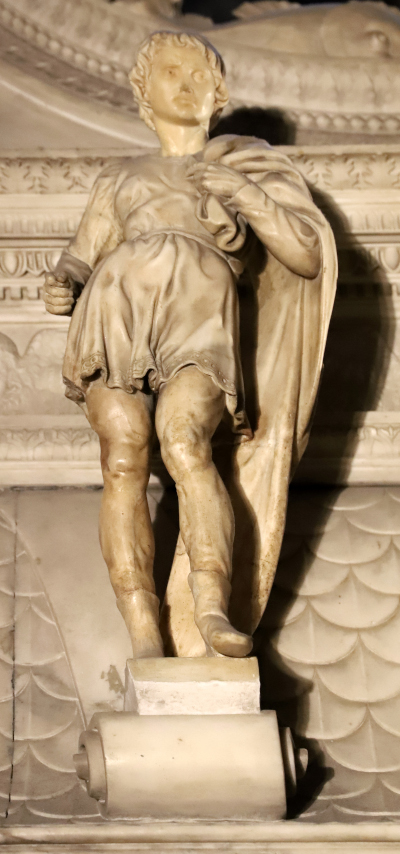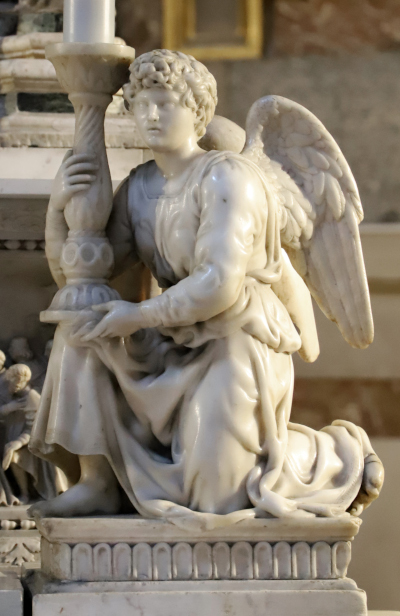Introduction
Michelangelo was promoting his talents and building a brand during these early years and so was more flexible in his approach towards dealing with patrons. He accepted this commission, whilst understanding that he would need to work in a similar manner to what had already been accomplished by others. It was also entirely common within the Renaissance for projects to run on for decades, meaning multiple artists who be involved at different stages in its lifecycle.
Whilst the three sculptures completed in Bologna by Michelagenlo were small, at around half a metre in height, they were beautifully detailed, particularly in terms of drapery, and so there was still considerable work to be done. Typically, young sculptors and painters who spend their formative years contributing in a small way to larger projects, before being trusted as the lead designer later on. Even the great Michelangelo would need to follow this path, although his rise through the ranks did move much more quickly than most.
The tomb itself was designed around its location in the city of Bologna, with the figures represented holding a strong connection to that region. Michelangelo would therefore have been informed as to who would be covered in these three sculptures, and then worked from that. The artist was paid for his work promptly after completing the pieces, as shown in receipts found years later, suggesting the patrons were happy with his work on St Petronius, St Proculus and his small Angel.
Table of Contents
- Introduction
- Description
- Michelangelo's Work in the Basilica of San Domenico
- Who was Saint Petronius?
- Size and Medium
Description
The marble sculpture features the bishop looking directly outwards, standing upright with a city model balanced on his left arm, supporting by his right hand. The figure appears middle aged, perhaps older, though the smooth nature of Michelangelo's marble surfaces would make it harder to determine age from a large distance. His large beard suggests wisdom, and his body is almost entirely covered in his wraps of clothing.
A small foot appear from beneath his robe, perhaps indicating a sandle, reflecting the humble nature of this figure. Symbolic value is delivered with the city model, clearly, but the rest of the portrait figure is really representative of the man himself and the life that he led. Some of the smaller details of the sculpture would be hard to spot for visitors, because of how the sculpture has been positioned in the tomb.
Of the three sculptures that Michelangelo completed within the tomb, this one can perhaps be considered the most complex. The combination of drapery with the city model would have added considerable amounts of time and attention to this sculpture. Those elements would also have to have been completed by his own hand, because of the precision involved, and it was also not until later in his career that Michelangelo was able to call upon a large studio to help out with his work.
A number of experts on Renaissance sculpture had pointed to how the Bishop's right foot creeps forward, giving the impression of his walking. This is likely to have been a subtle addition to the sculpture in order to symbolise his work within the local community, and the overall feeling of movement is added to be the rolls of material in his clothing, which are perhaps flowing in the wind.
Michelangelo's Work in the Basilica of San Domenico
Michelangelo was paid to complete one half-finished piece, whilst producing two further sculptures entirely from scratch. St Proculus was the related sculpture, and follows a similar approach to that found with St Petronius, focusing on a saint connected to the city of Bologna. Whilst Michelangelo was very young at this point, it would not be long before some of his most significant sculptures would appear, most of which were shortly after the turn of the century.
Who was Saint Petronius?
Saint Petronius, as represented by Michelangelo's sculpture from 1494-1495, was a fifty-century bishop, based in the Italian city of Bologna. He would eventually become a patron saint of the city, and was therefore a likely choice for inclusion within the Basilica of San Domenico, which itself celebrates key figures from the history of this region.
This important figure, known as San Petronio within Italy, was awarded a church and basilica in his name even before being portrayed by Michelangelo. Construction on the San Petronio, Bologna began as early as 1390 and so his legacy was already highly significant at the time of the construction of Michelangelo's small sculptured figures, more than a century later.
Petronius was highly educated, writing a number of publications on foreign cultures, whilst also travelling abroad in order to practice his faith and understand more about its roots. He was famous moral and virtuous, and would typically abstain from many pleasures in order to bring him closer to God, as well as providing the best example possible.
Size and Medium
Michelangelo's St. Petronius is 64cm in height, and was produced entirely in marble. All of the artist's work within the church is believed to have been completed over the period of 1494-1495, making it a relatively unusually efficient project for the great master. By joining an existing project, Michelangelo's requirements were clearly laid out, allowing him less creative freedom, but also ensuring a greater likelihood of the work being completed, as compared to other commissions from elsewhere in his career.
Image Credit
The image of this sculpture was originally provided by Sailko, onto Wikimedia. We have used it under the Creative Commons Attribution 3.0 Unported license and have resized it down to a smaller format. This contribution is much appreciated, and we encourage you to check out more of their photographs on that platform, many of which are of other Michelangelo sculptures and related Renaissance architecture.
Saint Dominic's ark, 1494-1495 by Michelangelo, sculpture of St. Petronius; Sailko, CC BY 3.0, via Wikimedia Commons
Bibliography
- Images sourced from Wikimedia under a variety of Creative Commons licenses. Further details regarding the particular license used, the location of the original image on Wikimedia and the original author/user are provided on each specific page.
- Michelangelo, Gilles Néret
- Vasari's Lives of the Artists, Giorgio Vasari
- Michelangelo. The Complete Works. Paintings, Sculptures, Architecture, Frank Zöllner, Christof Thoenes
- Michelangelo and the Sistine Chapel, Andrew Graham-Dixon







